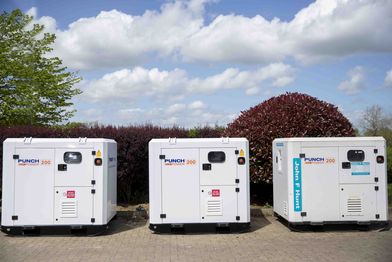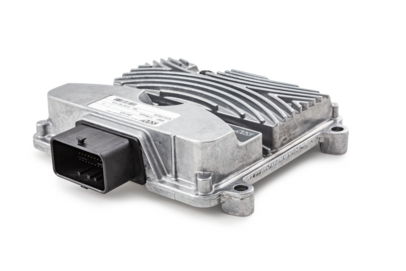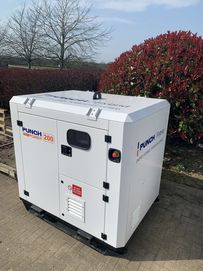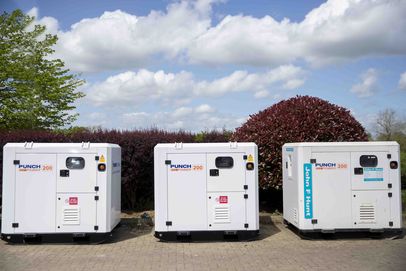Saving fuel and reducing emissions is an important aspect of all commercial operations, especially for mobile machinery. One solution for making the operation of construction and municipal machines more efficient is flywheel based energy storage, which absorbs energy during periods of low load and releases it again during peak loads. STW from Kaufbeuren supplies the ESX.3cs compact control unit for the energy management of such systems.
Energy is becoming more and more expensive, be it diesel, gas or electricity. Operators and manufacturers of mobile machines are looking for innovative concepts to reduce fuel consumption. One possibility is flywheel based energy storage systems such as those produced by PUNCH Flybrid. The energy storage system specialists from Silverstone, England, produce flywheel systems suitable for a range of applications in off-highway equipment, from excavators and tower cranes to mobile diesel and gas generators. The integrated flywheel system relieves the combustion engine from peak loads, and so enables smaller dimensioning of the engine and a net saving in fuel.
Optimized for tough environments
The solutions from PUNCH Flybrid are designed for high power density and durability, as required in construction, agricultural and municipal applications. Ordinary batteries or super capacitors often hit their limits here. PUNCH Flybrid, who developed the first KERS for Formula 1, are very familiar with extreme power peaks. The principle of the flywheel storage system is comparable to recuperation in electric vehicles. The flywheel captures the energy that would normally be lost when braking or, for example, lowering the boom of an excavator and releases it again during the next work cycle.
One of PUNCH Flybrid’s product is the PUNCH Power 200 (PP200), which is used for power generation applications. In this case, the flywheel storage system increases the efficiency of the generator significantly, and the additional power can be used either as a boost function or to save fuel.
Enormous benefits for construction machinery
Tobias Knichel, Managing Director at PUNCH Flybrid, explains typical application scenarios of the flywheel system: "Our solution is particularly advantageous in construction machinery with its recurring work cycles. A tower crane, for example, constantly alternates between idling and maximum power. The flywheel system is charged when the Diesel generator powering the tower crane is idling. As soon as the crane then needs to lift a heavy load and therefore demands high power from the Diesel generator, the flywheel injects energy at high power to support the Diesel generator. As a result, a smaller, more efficient Diesel generator can be used in combination with the flywheel energy system.
Depending on the application, this load-balancing concept can reduce fuel consumption by more than 50 per cent. Thanks to the flywheel system, a smaller main engine can be installed. This downsizing means the engine is operating with a higher base load, with increased efficiency. Excavators and other machines can also benefit from downsizing.
As with the tower crane, an excavator continuously performs cyclic work processes. The energy released as the excavator's boom is lowered can be captured in a PUNCH Flybrid energy storage system, whereas usually this excess energy is released as heat and is lost. The stored energy can then be used when the boom is raised again, reducing the load on the combustion engine. Tests have shown fuel savings of up to 30 percent. Other applications for the flywheel storage system can be found in power grid support or pump applications.
High performance control solution
For this approach to succeed without compromising the machine's productivity, a dynamic control solution is needed that reacts quickly to the operator's control signals. PUNCH Flybrid opted for a control system from the automation specialists at STW in Kaufbeuren, Germany. "We use the ESX.3cs as the master controller in our PUNCH Power 200 system. The controller provides the necessary high-speed signal processing that we need for our solution. It also monitors the entire system, including cooling" explains Tobias Knichel.
“The PUNCH Power 200 system provides the additional stored energy within 10-20 ms. "The ESX.3cs was the optimal solution for us. It handles the management of the power electronics, is robust enough for use in harsh environmental conditions and is compact enough to be easily integrated it into our system."
In the ESX.3cs, a 300 MHz fast 32-bit microcontroller with 4 MB flash and 8 MB SRAM handles the signal processing. External signals can be connected via two CAN interfaces, a serial interface, Ethernet or LIN interface. A second independent processor monitors various system voltages and the program execution. If necessary, it switches off all outputs via a second shutdown path or can reset the main controller. Digital and analog feedback for almost all signal branches allow comprehensive diagnosis of the system, including both inputs and outputs. Thanks to these features, functionally safe applications according to EN ISO 13849 and IEC 61508 can be implemented with the ESX.3cs. This is an important aspect for highly automated applications, as increasingly found in mobile machines.
The application suite for the ESX.3cs is a convenient basis for the developer to program the user application efficiently. Numerous functions, for example current controller and ramp functions for outputs, or frequency averaging for inputs, are already integrated in the programming environment.
The control system helps to provide machines with the capability to operate as efficiently as possible. The result is greatly reduced fuel consumption in the combustion engine and lower emissions. This benefits both the machine operators and the environment.





![[Translate to English:] [Translate to English:]](/fileadmin/_processed_/f/4/csm_Logo_41f8d03cbf.jpg)